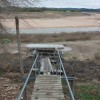Dried Out
Confronting the Texas Drought
By Chris Amico, Danny DeBelius,
Terrence Henry and Matt Stiles
In 2011, Texas endured the worst single-year drought in its history. Now the state has to make some hard choices about how to prepare for future droughts and water shortages as its population and water demand grows. Learn about the drought’s progression and its impact on the state, explore the pros and cons of the policy decisions that need to be made and share your stories.
A Drought of Historic Proportions
The current drought began in October 2010. Though the situation has improved recently, the drought is far from over — and the conditions that caused it aren’t going away anytime soon.
Texas is a place susceptible to extreme weather, and the last year was no exception. Thousands of square miles were burned in wildfires, billions were lost in agriculture, and its impact could still linger in years to come.
The interactive map to the right shows how extreme drought conditions enveloped Texas, beginning in the early summer of 2010. The chart below shows how much of the state was under drought conditions over time. The slide show includes a timeline of how the drought affected Texans. Share your story.
US Drought Area by Severity

Hover over legend colors for category definitions.
Surface Area of Texas in Drought by Severity
- Abnormally Dry
- Moderate Drought
- Severe Drought
- Extreme Drought
- Exceptional Drought
Drought Timeline
Far-Reaching Effects
The drought's impact has been severe, costing the state billions of dollars. These maps show where wildfires monitored by the Texas Forest Service spread last year, destroying homes and charring thousands of square miles.
Fires
Square Miles Burned
Homes Destroyed
Drought-Related Deaths
Hover over bubbles for fire data.
Larger symbols represent more homes lost.
Agricultural Losses 2011
$7.62 billion
Cattle Sector Losses 2011
$3.23 billion
Cotton Production Losses 2011
$2.2 billion
Policy Responses
Various plans for dealing with future droughts and growing demand for water in Texas exist, but most comprehensive — and accepted — is the state Water Plan. It offers a frank assessment of the current landscape, saying Texas “does not and will not have enough water to meet the needs of its people, its businesses, and its agricultural enterprises.” It predicts that “if a drought affected the entire state like it did in the 1950s,” Texas could lose around $116 billion, over a million jobs, and the growing state's population could actually shrink by 1.4 million people.
The water plan also offers a range of solutions for dealing with the problem, focusing mainly on conservation and efficiency, but also on building new reservoirs, tapping additional sources of water underground and treating effluent water. The biggest question, however is where the money will come from to pay for it. It has a price tag of $52 billion, or roughly $2,000 per Texan, through 2060. The state’s entire biennial budget for fiscal years 2012-2013 is just over $170 billion. Read more here.
Conservation
 Texas’ population is expected to increase 82 percent over the next 50 years, but the amount of water the state needs is expected to decline. Some of the water in the new plan is expected to come from conservation by municipal customers and farmers. While Texans aren’t generally known for limiting their water use, conservation strategies in San Antonio, El Paso and Austin, among others, have proven effective. Expect to see more stringent water restrictions as droughts become more frequent and severe.
Texas’ population is expected to increase 82 percent over the next 50 years, but the amount of water the state needs is expected to decline. Some of the water in the new plan is expected to come from conservation by municipal customers and farmers. While Texans aren’t generally known for limiting their water use, conservation strategies in San Antonio, El Paso and Austin, among others, have proven effective. Expect to see more stringent water restrictions as droughts become more frequent and severe.
New Reservoirs
 Most of the water will come from what the plan calls “other surface water,” which would involve better connecting existing surface water supplies and building off-channel reservoirs. That would provide 34 percent of the new water supplies in the plan.The plan also suggests building 26 new large reservoirs that would provide 16.7 percent of the new water needed in the plan. But they’re going to be costly, some of them topping $3 billion in construction costs. And they could face opposition from landowners.
Most of the water will come from what the plan calls “other surface water,” which would involve better connecting existing surface water supplies and building off-channel reservoirs. That would provide 34 percent of the new water supplies in the plan.The plan also suggests building 26 new large reservoirs that would provide 16.7 percent of the new water needed in the plan. But they’re going to be costly, some of them topping $3 billion in construction costs. And they could face opposition from landowners.
Tapping Underground Water
 Groundwater will provide another 9 percent of Texas’ new water in the new plan, through desalination, new wells, treatment plants and other strategies to maximize supply. But desalination, used for some ground water and also sea water, is expensive and energy-intensive. Groundwater also is still a thorny legal issue.
Groundwater will provide another 9 percent of Texas’ new water in the new plan, through desalination, new wells, treatment plants and other strategies to maximize supply. But desalination, used for some ground water and also sea water, is expensive and energy-intensive. Groundwater also is still a thorny legal issue.
Treating Wastewater
 Treating and reusing wastewater from cities makes up ten percent of the new water supply, but the biggest obstacle here is the yuck factor. (That hasn’t stopped people in Houston, who drink treated wastewater sent down from Dallas every year.) And it could lead to more disputes over sourcing and water rights.
Treating and reusing wastewater from cities makes up ten percent of the new water supply, but the biggest obstacle here is the yuck factor. (That hasn’t stopped people in Houston, who drink treated wastewater sent down from Dallas every year.) And it could lead to more disputes over sourcing and water rights.
Fire Prevention and Preparedness
 Funding for the Texas Forest Service is down $34.7 million for the next two years after cuts by the 82nd Texas Legislature in 2010, with most of the reduction hitting grants to volunteer fire departments. The Texas Forest Service says that they “will place a priority on training, protective equipment and clothing” in distributing what funds they do have to the volunteers, but that the reductions will prevent them from ordering any new trucks this year and next.
Funding for the Texas Forest Service is down $34.7 million for the next two years after cuts by the 82nd Texas Legislature in 2010, with most of the reduction hitting grants to volunteer fire departments. The Texas Forest Service says that they “will place a priority on training, protective equipment and clothing” in distributing what funds they do have to the volunteers, but that the reductions will prevent them from ordering any new trucks this year and next.
Join the Discussion
We want to hear your story. Tell us how the drought has affected your business, your home — or your way of life. Send us your stories, photos or videos.
You can email them to news@kut.org, or you can leave a voicemail at (512) 537-SITX (7489). Please include a name and email address or phone number so we can contact you.
You can also share your thoughts and images with other readers in comment box to the right.














